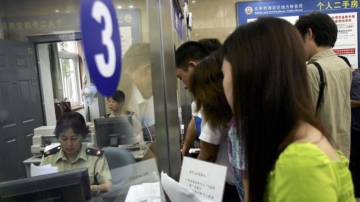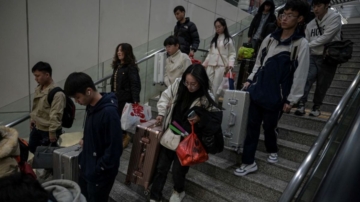【新唐人2014年08月20日讯】1998年,中共推出首轮“国有企业私有化”改革,结果是中央级的国企在主要行业形成了权贵垄断,不过,属于地方政府的国企当年却没那么“幸运”。日前,外国媒体披露,中共地方政府的债务正在推进新一轮的“国有企业私有化”改革。评论表示,中共把中国经济引导到崩溃边缘的时候,利用“私有化”攫取财富。
日前,英国《金融时报》报导说,中共正在推进新一轮的国有企业私有化改革,比起20年前的首轮私有化,这次是中共地方政府的债务,在推动第二轮“私有化”进程。
报导引述世界银行前官员、中国局局长杜大伟(David Dollar)的话说,大陆部分地方政府过度举债,难以偿还,地方债问题是私有化的重要推手。
报导说,出售国企的股权能帮助政府偿还超过2.9万亿美元的债务,这个数字相当于国内生产总值(GDP)的58%。
美国南卡罗莱纳大学艾肯商学院谢田教授:“地方政府为了搞GDP,拉下巨大的债务,地方政府开始要把他们手中占有的和他能抓得到的那些国企来私有化、来还债,中国老百姓来贴补这个黑窟窿。”
美国南卡罗莱纳大学艾肯商学院的谢田教授认为,目前中共政府发起第二轮国企私有化的目的,跟第一次“国企私有化”相似,都是在把经济搞砸了,并且从中捞够了钱之后,把剩下的亏空和烂摊子让老百姓来买单。
由于文革拖垮了中国经济,为挽救执政危机,中共在1978年,开始进行所谓的“经济体制改革”。
而所谓的“国企改革”在1992年开了头。在邓小平南巡后,国企掀起了所谓的破除“铁饭碗”、“铁工资”和“铁交椅”的热潮,但随后严重的失业迅速演变成一场社会危机。仅据中共劳动部门公布的资料,1993年下岗累计300万人,到1998年,已经累计达到1714万人。
1996年,国有企业亏损达到了前所未有的程度。同年国企大规模上市,两大股市代替国家财政,成为向国企输血的工具。而上市并没有改变国企普遍亏损、普遍高负债的经营状况。1997年国企亏损仍在恶化。为摆脱困境,1998年,中共进行“国企私有化”改革。
但改革并没有给老百姓带来利益。资料显示,1998年至2000年,国企职工失业人数达到2137万人,3年间以每年600万的速度增长。
而这3年,中共国家支付大量资金救赎国有企业,共核销银行呆坏账1261亿元,实施债转股4050亿元,剥离国有企业不良资产13000亿元。同时,307家国有企业优先上市,筹集资金2723亿元,在国外上市国有企业达到22家。
北京国情内参首席研究员巩胜利表示,中国的国有企业分中央级、省级、地市县级国有企业,在“国企私有化”的过程中,大型央企占据垄断地位。
北京国情内参首席研究员巩胜利:“主要的、所有的电力、银行、水利,还包括土地,很多都是国有企业垄断,它的垄断不仅是垄断了市场,而且垄断了资本,还有产业链,在它下面的中小企业几乎是寸草不生。”
谢田:“中共建政到‘文化大革命’以后,(中共)它们把中国经济引导到崩溃边缘的时候,它们发现可以鼓励私有化,一是放开竞争,再一个实际上也给那些官员以权谋私,把国有企业私家分赃、分到中共官员手中。”
谢田表示,只要中共政权在,就绝对不会放松在经济上的控制,中国老百姓也不能够真正保障自己的权益。
采访编辑/易如 后制/舒灿
Privatization of State-Owned Enterprises To Resolve
Local Debts Or To Plunder People’s Wealth?
In 1998, the CCP launched the first round
of state-owned enterprises (SOE) privatization.
Consequently, Central SOEs became powerful monopolies
in their relevant industries.
But, local SOEs were not so lucky.
Recently, foreign media reported that local debts
have pushed another round of SOE privatization..
Critics comment that the CCP had led the Chinese economy
to the verge of collapse, and is now manipulating
the privatization of SOEs to grab wealth.
British Financial Times (FT) reported that China is pushing
a fresh round of SOE privatization.
It is local governments’ debt behind this privatization
compared to the one promoted nearly two decades ago.
FT quoted, "Local government debt problems
will be an important driving force of SOE privatization,"
says David Dollar, former World Bank country director
for China.
Selling stakes in locally owned SOEs will help local
governments pay down more than $2.9tn in debt, equivalent
to 58 percent of gross domestic product, added FT.
Professor Frank Xie of Business School, University of South
Carolina Aiken: "Local governments engage in privatization
of local SOEs to have people to pay for their debts so that
they can drive the GDP."
Professor Frank Xie believes the second round of SOE
privatization serves the same purpose as that of the first
privatization.
That is to fish out a quick buck, leave the deficit and mess
to the people and ruin the economy.
The CCP conducted economic reform in 1978 to save
its ruling power from the Chinese economic collapse.
The SOEs reform started in 1992 after Deng Xiaoping's
southern tour.
The SOEs went through breaking the "iron rice bowl"
or job security trend.
The following unemployment quickly turned
into a social crisis.
The CCP Labor Department data showed laid off accumulated
from 3 million in 1993 to 17.14 million people in 1998.
In 1996, SOE losses reached an unprecedented level.
The same year, many SOEs became listed companies.
The two major stock markets became a tool to transfer wealth
to the listed SOEs.
The listings did not improve the general loss and high debts
of SOEs.
In 1997, the SOEs continued to deteriorate.
To overcome adversity, CCP started the first privatization
of SOEs in 1998.
This reform did not benefit the people.
Data shows that from 1998 to 2000, the number
of unemployed workers in SOEs reached 21.37 million,
at a growth rate of six million per year.
In those three years, the CCP exploited national assets to save
SOEs by writing off a total of 126.1 billion yuan of bad
loans, turning 405 billion yuan of debts into stocks,
stripping 1.3 trillion yuan of bad assets from SOEs.
Meanwhile, 307 SOEs had the priority to be listed to raise
272.3 billion yuan of funds while 22 SOEs
were listed overseas.
Chief economic researcher of Beijing think tank,
Gong Shengli, indicates that SOEs at all levels, from
the Central to local, occupied monopoly status during
the privatization process.
Gong Shengli: "The electricity, banking, water conservancy,
land, many are state-owned monopolies.
Its monopoly is not just in the market, but also in the capital
and the industrial chain.
The SMEs below it are almost deserted."
Frank Xie: "Since the establishment of its regime up until
the Cultural Revolution, when the CCP led the Chinese
economy to the brink of collapse, it realized the privatization
will allow for competition, and the officials
to abuse power for private spoils."
Frank Xie indicates the CCP regime will never loosen its grip
on the economy or allow the people to protect their interests.
Interview & Edit/YiRu Post-Production/ShuCai
日前,英国《金融时报》报导说,中共正在推进新一轮的国有企业私有化改革,比起20年前的首轮私有化,这次是中共地方政府的债务,在推动第二轮“私有化”进程。
报导引述世界银行前官员、中国局局长杜大伟(David Dollar)的话说,大陆部分地方政府过度举债,难以偿还,地方债问题是私有化的重要推手。
报导说,出售国企的股权能帮助政府偿还超过2.9万亿美元的债务,这个数字相当于国内生产总值(GDP)的58%。
美国南卡罗莱纳大学艾肯商学院谢田教授:“地方政府为了搞GDP,拉下巨大的债务,地方政府开始要把他们手中占有的和他能抓得到的那些国企来私有化、来还债,中国老百姓来贴补这个黑窟窿。”
美国南卡罗莱纳大学艾肯商学院的谢田教授认为,目前中共政府发起第二轮国企私有化的目的,跟第一次“国企私有化”相似,都是在把经济搞砸了,并且从中捞够了钱之后,把剩下的亏空和烂摊子让老百姓来买单。
由于文革拖垮了中国经济,为挽救执政危机,中共在1978年,开始进行所谓的“经济体制改革”。
而所谓的“国企改革”在1992年开了头。在邓小平南巡后,国企掀起了所谓的破除“铁饭碗”、“铁工资”和“铁交椅”的热潮,但随后严重的失业迅速演变成一场社会危机。仅据中共劳动部门公布的资料,1993年下岗累计300万人,到1998年,已经累计达到1714万人。
1996年,国有企业亏损达到了前所未有的程度。同年国企大规模上市,两大股市代替国家财政,成为向国企输血的工具。而上市并没有改变国企普遍亏损、普遍高负债的经营状况。1997年国企亏损仍在恶化。为摆脱困境,1998年,中共进行“国企私有化”改革。
但改革并没有给老百姓带来利益。资料显示,1998年至2000年,国企职工失业人数达到2137万人,3年间以每年600万的速度增长。
而这3年,中共国家支付大量资金救赎国有企业,共核销银行呆坏账1261亿元,实施债转股4050亿元,剥离国有企业不良资产13000亿元。同时,307家国有企业优先上市,筹集资金2723亿元,在国外上市国有企业达到22家。
北京国情内参首席研究员巩胜利表示,中国的国有企业分中央级、省级、地市县级国有企业,在“国企私有化”的过程中,大型央企占据垄断地位。
北京国情内参首席研究员巩胜利:“主要的、所有的电力、银行、水利,还包括土地,很多都是国有企业垄断,它的垄断不仅是垄断了市场,而且垄断了资本,还有产业链,在它下面的中小企业几乎是寸草不生。”
谢田:“中共建政到‘文化大革命’以后,(中共)它们把中国经济引导到崩溃边缘的时候,它们发现可以鼓励私有化,一是放开竞争,再一个实际上也给那些官员以权谋私,把国有企业私家分赃、分到中共官员手中。”
谢田表示,只要中共政权在,就绝对不会放松在经济上的控制,中国老百姓也不能够真正保障自己的权益。
采访编辑/易如 后制/舒灿
Privatization of State-Owned Enterprises To Resolve
Local Debts Or To Plunder People’s Wealth?
In 1998, the CCP launched the first round
of state-owned enterprises (SOE) privatization.
Consequently, Central SOEs became powerful monopolies
in their relevant industries.
But, local SOEs were not so lucky.
Recently, foreign media reported that local debts
have pushed another round of SOE privatization..
Critics comment that the CCP had led the Chinese economy
to the verge of collapse, and is now manipulating
the privatization of SOEs to grab wealth.
British Financial Times (FT) reported that China is pushing
a fresh round of SOE privatization.
It is local governments’ debt behind this privatization
compared to the one promoted nearly two decades ago.
FT quoted, "Local government debt problems
will be an important driving force of SOE privatization,"
says David Dollar, former World Bank country director
for China.
Selling stakes in locally owned SOEs will help local
governments pay down more than $2.9tn in debt, equivalent
to 58 percent of gross domestic product, added FT.
Professor Frank Xie of Business School, University of South
Carolina Aiken: "Local governments engage in privatization
of local SOEs to have people to pay for their debts so that
they can drive the GDP."
Professor Frank Xie believes the second round of SOE
privatization serves the same purpose as that of the first
privatization.
That is to fish out a quick buck, leave the deficit and mess
to the people and ruin the economy.
The CCP conducted economic reform in 1978 to save
its ruling power from the Chinese economic collapse.
The SOEs reform started in 1992 after Deng Xiaoping's
southern tour.
The SOEs went through breaking the "iron rice bowl"
or job security trend.
The following unemployment quickly turned
into a social crisis.
The CCP Labor Department data showed laid off accumulated
from 3 million in 1993 to 17.14 million people in 1998.
In 1996, SOE losses reached an unprecedented level.
The same year, many SOEs became listed companies.
The two major stock markets became a tool to transfer wealth
to the listed SOEs.
The listings did not improve the general loss and high debts
of SOEs.
In 1997, the SOEs continued to deteriorate.
To overcome adversity, CCP started the first privatization
of SOEs in 1998.
This reform did not benefit the people.
Data shows that from 1998 to 2000, the number
of unemployed workers in SOEs reached 21.37 million,
at a growth rate of six million per year.
In those three years, the CCP exploited national assets to save
SOEs by writing off a total of 126.1 billion yuan of bad
loans, turning 405 billion yuan of debts into stocks,
stripping 1.3 trillion yuan of bad assets from SOEs.
Meanwhile, 307 SOEs had the priority to be listed to raise
272.3 billion yuan of funds while 22 SOEs
were listed overseas.
Chief economic researcher of Beijing think tank,
Gong Shengli, indicates that SOEs at all levels, from
the Central to local, occupied monopoly status during
the privatization process.
Gong Shengli: "The electricity, banking, water conservancy,
land, many are state-owned monopolies.
Its monopoly is not just in the market, but also in the capital
and the industrial chain.
The SMEs below it are almost deserted."
Frank Xie: "Since the establishment of its regime up until
the Cultural Revolution, when the CCP led the Chinese
economy to the brink of collapse, it realized the privatization
will allow for competition, and the officials
to abuse power for private spoils."
Frank Xie indicates the CCP regime will never loosen its grip
on the economy or allow the people to protect their interests.
Interview & Edit/YiRu Post-Production/ShuCai








